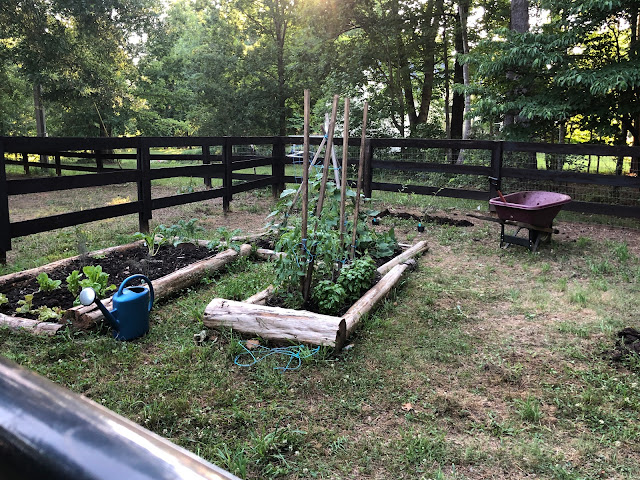I’ve had a lot of plans for the potager but haven’t had the time to go all in with them yet, so when the NC Botanical Garden plant sales opened back up by appointment and no contact pick up, I couldn’t resist leaping at the opportunity to get some pollinator plants into the space.
While planting perennials this time of year means a lot of watering and care, we’re already doing that for the vegetable plants, so it’s just a matter of standing with the hose a bit longer than we already do.
I’m going to do separate posts on the new plants I’ve added, but the list includes Appalachian bergamot, narrow leaf mountain mint, foxglove beardtongue, Atlantic blue-eyed grass, and climbing aster.
This is the main vegetable section, with lettuces, chard, and kale still going, cucumbers going crazy, and tomatoes and basil. There are also two bronze fennel that will be for pollinators - they’re growing but really blend into the landscape in this photo!
The squash side with yellow squash and zucchini, plus a couple of new tomato plants.
To prep the pollinator plant bed I wet the ground, then put a layer of our compost, put down plain cardboard (recycled from packaging) that I wet thoroughly on both sides, then another layer of compost. Wetting the cardboard down makes it easier to dig through when planting.
And the finished new bed. It’s hard to see the plants with the grass behind but once they settle in and grow I’ll get a better shot. I also didn’t take a larger photo of the entire area, but this pollinator bed will be the central focus of the potager when you come through the gate.
If you look to the left of the wheelbarrow in this photo you’ll see the three climbing asters not yet in the ground. I’ll be putting two posts in the ground and a 10-foot wire panel for them to climb. When mature, along with the hazelnut to the left, these will create a nice screen along the fence line.
To the left of the interior potager boundary fence, in that corner just outside the potager, I’m building a two-bay compost area where we can compost manure and garden wastes for easy access to the garden beds. I’m thinking of putting wire panels in the back of the compost bays to plant something like native coral honeysuckle which will carry the screening along the perimeter fence line.
This week if the rain doesn’t prohibit it, I’d like to get the climbing asters situated with their panel, get the compost bays set up, and upcycle our old huge mailbox into garden tool storage here in the potager.
I’ll probably be adding some new vegetables to the lettuce bed as those finish up, and maybe a few melon mounds. And in the fall I’ll add more flowers to this space along with a couple of chairs for sitting. It’s starting to take on the potager “feel” I had when I first came up with the idea to make this space, and that makes me happy.










